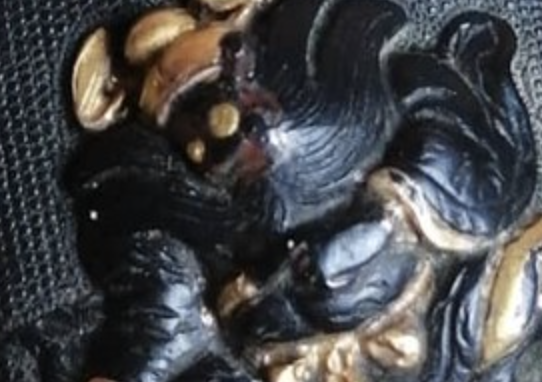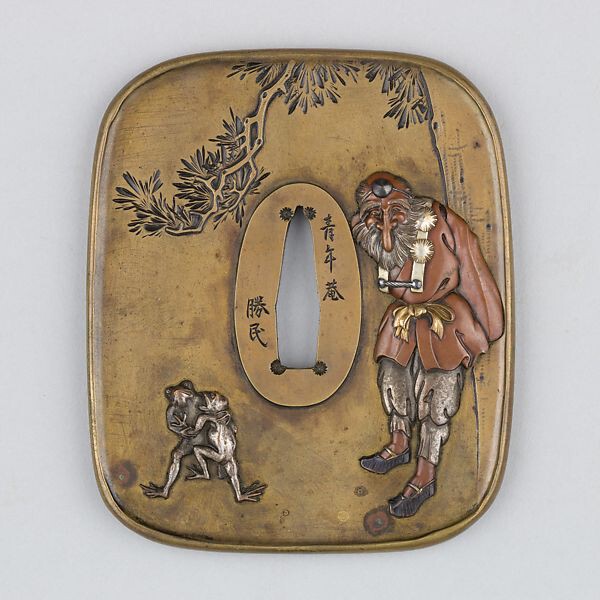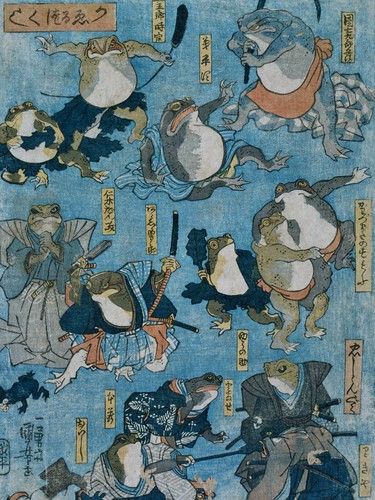-
Posts
858 -
Joined
-
Last visited
-
Days Won
7
Everything posted by Tanto54
-
Dear Eric, As Yas said, the "Backing Material" or "filling" is a mixture of urushi (lacquer - or the sap of a certain kind of tree) and other materials. Its purpose is not “support” (meaning to keep the menuki from being crushed - as Barry said, that would not be necessary in his iron menuki). Instead, it is an adhesive or leveler. The mixture may have several different names depending upon the use and materials mixed with the lacquer. Mugi-urushi or nori-urushi is lacquer mixed with wheat or rice flour to make a glue. Sabi-urushi has powdered burnt clay mixed in for building up or leveling things. Kokuso-urushi has sawdust or plant fibers mixed in with wheat/rice flour and urushi to make an adhesive filler putty. Remember that Menuki are sometimes glued to the tsuka (handle) and do not have ito or tsukamaki (the cord often wrapped around the handle) to help hold the menuki in place. One of the urushi adhesives mentioned above can be used to fill the back of the menuki and glue them onto the tsuka (e.g., a bare samegawa - ray skin - handle). So even if your menuki were wrapped with ito or tsukamaki, perhaps they were not at sometime in the past. The other reason that these urushi mixtures are sometimes used is as a “leveler”. Remember how the nodules of the samegawa or ray skin can be bumpy and uneven. Also consider how the edges of the backs of the menuki are slightly concave and may not sit perfectly straight on the samegawa. Therefore, one of the filler urushi mixtures can be used to “level” the menuki on the ray skin and keep them from shifting (even if they are covered with tsukamaki)... The filler on your menuki looks like Kokuso-urushi to me (it appears to have sawdust/plant fibers mixed with the lacquer). Here's a beautiful example of a glued menuki from www.yuhindo.com
-
Hey Curran, you are correct, item 106 is 知熊 Chikuma or Tomokuma. Neither are listed in Haynes and frankly, it looks like a BS name to me... Translates to "Knowing Bears" - what is he, a Native American??? Very poorly cut mei, so I'm leaning towards BS....
-
Matt, I second Michael - truly high class! That katakiribori carving is flawless - shows a true master's hand - no hesitation or halting cuts.
-
Hi John, I don't think that the magnet test is really an indicator of fakes. As you know, many of the legitimate tsuba are not iron and will not attract a magnet, so the magnet test merely tells you whether the "tsuba" is attracted to a magnet or not (and therefore gives you a better idea of what the tsuba is made of). When I look at the tsuba in question, I think it is trying to emulate shakudo or shibuichi. Neither of those alloys would be attracted to a magnet, so the magnet test would not give any indication of whether it was fake or not.
-
Tsuba are like cowbells...
-
Your eye is getting better Jesse. There are many other indicators, but as Mark said the poorly painted gold and silver should tip you off right away. Another clear tip is the rough edge from casting/stamping. Another more subtle hint (one that is good to use for the better fakes) is that the signature (mei) looks pressed in (cast or stamped) instead of cut with a chisel.
-

Fakery and what to do about it
Tanto54 replied to Peter Bleed's topic in General Nihonto Related Discussion
When the Museum of Fine Arts Boston made replica netsuke for sale in their gift-shop, they incised "MFN" deeply into the bottom of the Netsuke in a way that it could not be removed (they anticipated this resale problem...). Peter, you made the tsuba, so why not sign them with your name (deeply) so it cannot be filed away without leaving evidence? Similarly, Bruce could indelibly mark his fake in various places (once we are absolutely sure it is a fake - I get your point) before selling it with full disclosure. I also wonder whether we should attempt to ferret out some of the modern counterfeiters. Some of them are clearly making molds of authentic pieces and replicating them for sale on Yahoo Japan. These dealers in Japan also sell the originals, so it's not that hard to figure out who they are.... (a few of these Japanese Dealers are mentioned from time to time on the NMB...). Any chance of luring them to Saudi Arabia for a sale where they cut people's hands off for this kind of stuff? Just kidding - kind of..... -

Whats the boards take on these Menuki?
Tanto54 replied to Infinite_Wisdumb's topic in Auctions and Online Sales or Sellers
Just a few thoughts on these so we don't miss out on possible hidden gems in the future. Tobacco pouch pins don't come in pairs, so the pairs above are not pouch pins. The lobsters have unusual pins (too thin for antique menuki) and shape, so they are probably modern pressed menuki for modern decorative swords. Menuki are often repurposed for Tobacco pouch pins, obidome (the decorative "buckle" on the thin rope that goes around a women's obi/belt on her kimono), Western broaches, etc. If you look carefully, you will see the vestiges of menuki posts (in the middle) on a few of the items in the picture and the later added two thin pins toward the edges (that shows that it is a menuki that was converted to a pouch pin). Finally, some menuki were glued on with pitch and never had any pin or post at all (see one above that appear to have their backs filled with pitch). I'm not saying any of these are gems, but you will often find great menuki that have been converted to other uses. -
-
Dear Jesse, older high level menuki often have rounded posts - one solid and one hollow (see photos below). Another sign of age and quality is Uttori (the use of thick gold foil instead of gold wash - see photo below from the backside of the tail of the Dragon from my menuki posted above) - you can tell that it is gold foil folding over the edge instead of being brushed on like paint.
-
The Dragon Boat Menuki is about 2.5 inches long (a little over 6cm). The main body of the menuki is only about 1.75 inches, but the dragon tail adds another .75 inches to the length. Here's the back:
-
Dear Kirill, I have seen household agency provenance paperwork on such Sadakatsu swords, so at least some were owned by the Imperial household. Of course, that doesn't mean that some of the others were not made and distributed as you say... (I don't know)
-
Thanks for the Quiz - very well done. I know the theme too, so I'll let others have some fun researching.
-
I'd look for equal effort for the "tosogu" members (who could become the majority in the future...) Just to be clear, Paul, you obviously do a great job and this is not any kind of criticism (and yes, I know this is in the Nihonto section), but I often feel like almost everyone is focused on the blades and tosogu are an afterthought (or the redheaded stepchild) in many of these organizations.
-
Like Curran, I'd like to see the insides. I'm intrigued by the differences in the nanako.
-

Japanese style reproduction friend won’t accept it!
Tanto54 replied to Bjj's topic in General Nihonto Related Discussion
Christian, Tell your friend that I can get a thousand more exactly like this if we wants to buy some more of these "treasures"..... -
Dear Adam, you menuki are Kutsuwa (horse bit) with a family mon. As for the tsuba, compare the quality of the work that you found on those several examples with your tsuba - I don't think yours was made by the same artist.
-
Like Adam said, the Oni stealing Shoki's Sword is a classic, humorous scene. I'm wondering what is going on with Shoki's face. It looks like it sustained extensive damage and someone has tried to repair / cover up the damage. Look closely at his face and beard - I wouldn't buy it without getting better photos of that area and making sure it is not damaged. Shoki should look like this:
-
Hi Alex, we will need to see better pictures and pictures of the Nakago (tang) to confirm whether the sword is authentic or not. Some of the parts (e.g., the tsuba or blade guard) are not authentic (i.e., the tsuba is a modern fake). Can't give a price until we see more of the sword.
-
Difficult to tell for sure from photos but the menuki look like they could be solid gold (low karat).
-

Estate Tanto strange Saya Wedding Gift?
Tanto54 replied to Foletta's topic in General Nihonto Related Discussion
Piers? A tanto is part of a standard bridal trousseau for "Bushi stock", so I don't see why this would be unlikely at all... (in fact, quite commonplace) -
I have seen that type of black "tarnish" on old, low karat gold menuki (obviously not the gold corroding, but something else in the alloy). On the other hand, the quality would usually be better with gold... Do any of your friends have a good metal detector? They can give you a good idea of what is in the metal with nondestructive tests, or many coin collectors or pawn shops will have the reagent necessary to test for gold with a small rubbing on the back. Perhaps Ford or one of the others who know more about metals will comment.
-
Hi Moley, for at least 800 years since the initial publication of the Chōjū-jinbutsu-giga (鳥獣人物戯画, literally "Animal-person Caricatures”) four comic scrolls, the Japanese have been using anthropomorphic Toads, Mice, Rabbits, etc. illustrated in human activities (like wrestling) for humor. On Adam’s menuki, I think that I can see the Sumo Referee’s (a 3rd Toad’s) Gunbai (wooden war-fan used by the referee to signal the winner) in this case a leaf (I’ve circled the leaf on Adam’s menuki and the one in the famous Woodblock Print of Sumo Wrestling Toads below).
-
The Menuki are two "wrestling" toads.
-
Nice Detective work Pietro! So he is just jerking our chain again. I guess now that he has been exposed in this and the previous thread, he has lost all his dignity and there will be no graceful exit for the "Bear" (Babu).

















